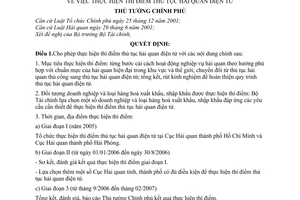Nội dung toàn văn Decision no. 149/2005/QD-TTg of June 20, 2005 on the pilot implementation of e-customs procedures the prime minister
|
THE
PRIME MINISTER OF GOVERNMENT |
SOCIALIST REPUBLIC OF VIET NAM |
|
No. 149/2005/QD-TTg |
Hanoi, June 20, 2005 |
DECISION
ON THE PILOT IMPLEMENTATION OF E-CUSTOMS PROCEDURES THE PRIME MINISTER
Pursuant to the December 25,
2001 Law on Organization of the Government;
Pursuant to the June 29, 2001 Customs Law;
At the proposal of the Minister of Finance,
DECIDES:
Article 1.- To permit the pilot implementation of e-customs procedures with the following major contents:
1. Objectives of the pilot implementation: To step by step renew customs operations in conformity with modern customs standards in the region and the world; to shift from manual customs procedures to e-customs procedures; to review and draw experience so as to perfect the process of e-commerce procedures.
2. Enterprises and import and export goods entitled to the pilot implementation: The Ministry of Finance shall select some enterprises and categories of import and export goods, that meet requirements necessary for the pilot implementation of e-customs procedures.
3. Time and venue of the pilot implementation:
a/ Phase I (2005)
To organize the pilot implementation of e-customs procedures at the Customs Departments of Ho Chi Minh city and Hai Phong city.
b/ Phase II (from January 1, 2006 to August 30, 2006)
- To preliminarily review and evaluate the results of the pilot implementation in phase I.
- To select some other provincial/municipal Customs Departments qualified for the pilot implementation of e-customs procedures.
c/ Phase III (from September 2006 to February 2007)
To review, evaluate and report to the Prime Minister on the results of the pilot implementation.
Article 2.- Pilot implementation of e-customs procedures covers the following contents:
1. Customs procedures shall be carried out by electronic means through the electronic data processing system of customs offices.
2. The e-customs dossiers are ensured in their integrity with standardized forms and legal validity like paper customs dossiers.
3. To comply with regulations allowing customs declarers to declare and pay taxes and other collections by themselves. To apply the form of monthly payment of fees for carrying out customs procedures.
4. Customs offices shall carry out customs procedures on the basis of e-customs dossiers filed by enterprises; make decisions on customs clearance on the basis of e-dossiers declared by enterprises; make decisions on customs inspection based on the results of analyzing information from their database and other information sources.
Article 3.- Responsibilities of enterprises carrying out e-customs procedures:
1. To declare and carry out e-customs procedures through the e-customs data processing system.
2. To declare and pay taxes by themselves according to the provisions of law on customs and taxes.
3. To pay customs fees monthly.
4. To bear responsibility before law for the accuracy and truthfulness of declared contents, vouchers submitted or produced to customs offices as well as the consistency of contents between the paper customs dossiers and their e-customs dossiers.
5. To archive customs dossiers, accounting books and vouchers and other vouchers related to import or export goods already cleared from customs procedures for a duration of five years counting from the date of registration of customs declarations; to produce dossiers, supply relevant information and vouchers (in both paper and electronic forms) when so requested by customs offices according to regulations.
Article 4.- The General Department of Customs shall have to organize a specialized apparatus so as to efficiently carry out e-customs procedures:
1. To propagate and support enterprises engaged in the pilot implementation of e-customs procedures to understand and strictly comply with the provisions of law on customs and e-customs procedures provided for in this Decision.
2. To monitor the implementation of e-customs procedures by enterprises engaged in the pilot implementation thereof; to notify, warn or handle according to law provisions cases of violation.
3. To inspect and handle in time according to its competence acts of violating law on customs.
4. To provide suitable training and re-training on customs operations for pilot implementation of e-customs procedures. To step up the application of information technology to customs management activities.
Article 5.- Responsibilities of the Ministry of Finance
1. To promulgate documents guiding the implementation of this Decision; to work out measures to prevent and restrict the abuse of e-customs procedures for tax fraudulence or evasion.
2. To assume the prime responsibility for, and coordinate with the Ministry of Trade, the Ministry of Public Security, the Ministry of Post and Telematics, the Ministry of Transport and concerned ministries and branches in, organizing the pilot implementation of e-customs procedures.
3. To direct and inspect customs offices in organizing the realization of contents defined in Article 3 of this Decision.
4. To propose and promulgate mechanisms and policies necessary for the official implementation of e-customs procedures nationwide.
5. To ensure necessary conditions on information technology infrastructures, mechanisms and policies to encourage organizations and individuals to carry out e-customs procedures.
Article 6.- Agencies, enterprises and organizations shall have to supply information related to enterprises engaged in the pilot implementation of e-customs procedures at the request of customs offices; functional agencies shall coordinate with customs offices in settling problems and handling cases of violating the legislation on customs and the provisions of this Decision.
Article 7.- This Decision takes effect 15 days after its publication in “CONG BAO.”
The ministers, the heads of the ministerial-level agencies, the heads of the Government-attached agencies, and the presidents of the provincial/municipal People’s Committees shall have to implement this Decision.
|
|
PRIME
MINISTER |




